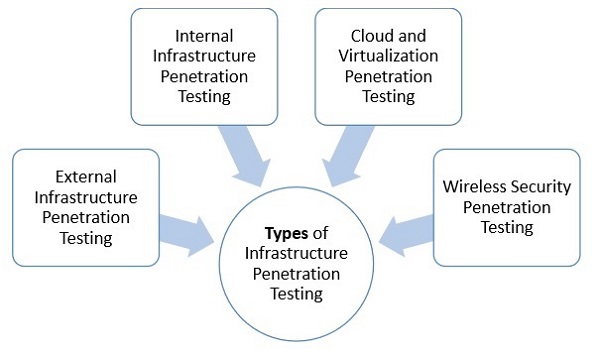
- Penetration Testing Tutorial
- Penetration Testing - Home
- Penetration Testing - Introduction
- Penetration Testing - Method
- Testing Vs. Vulnerability Assessment
- Penetration Testing - Types
- Manual and Automated
- Penetration Testing - Tools
- Penetration Testing - Infrastructure
- Penetration Testing - Testers
- Penetration Testing - Report Writing
- Penetration Testing - Ethical Hacking
- Pen Testing Vs. Ethical Hacking
- Penetration Testing - Limitations
- Penetration Testing - Remediation
- Penetration Testing - Legal Issues
- Penetration Testing Resources
- Penetration Testing - Quick Guide
- Penetration Testing - Resources
- Penetration Testing - Discussion
Penetration Testing - Infrastructure
Computer systems and associated networks normally consist of a large number of devices and most of them play a major role in conducting total works and businesses of the respective system. A minor flaw at any point of time, and at any part of these devices may cause great damage to your business. Therefore, all of them are vulnerable to risk and need to be secured properly.
What is Infrastructure Penetration Testing?
Infrastructure penetration testing includes all internal computer systems, associated external devices, internet networking, cloud and virtualization testing.
Whether hidden on your internal enterprise network or from public view, there is always a possibility that an attacker can leverage which can harm your infrastructure. So, it is better to be safe in advance rather than regret later.
Types of Infrastructure Penetration Testing
Following are the important types of infrastructure penetration testing −
- External Infrastructure Penetration Testing
- Internal Infrastructure Penetration Testing
- Cloud and Virtualization Penetration Testing
- Wireless Security Penetration Testing

External Infrastructure Testing
The penetration test, targeting the external infrastructure discovers what a hacker could do with your networks, which is easily accessible through the Internet.
In this testing, a tester normally replicates the same kind of attacks that the hackers can use by finding and mapping the security flaws in your external infrastructure.
There are various benefits of leveraging external infrastructure penetration testing, as it −
Identifies the flaws within the firewall configuration that could be misused
Finds out how information can be leaked out from your system by an attacker
Suggests how these issues can be fixed
Prepares a comprehensive report highlighting the security risk of the border networks, and suggests solutions
Ensures overall efficiency and productivity of your business
Internal Infrastructure Penetration Testing
Due to some minor internal security flaws, hackers are illegally committing frauds in large organizations. So, with internal infrastructure penetration testing, a tester can identify the possibility of a security and from which employee, this problem has occurred.
Internal infrastructure penetration testing benefits as it −
Identifies how an internal attacker could take advantage of even a minor security flaw.
Identifies the potential business risk and damage that an internal attacker can inflict.
Improves the security systems of internal infrastructure.
Prepares a comprehensive report giving details of the security exposures of internal networks along with the detailed action plan on how to deal with it.
Cloud and Virtualization Penetration Testing
As you buy a public server or wave space, it significantly increases the risks of data breach. Further, identifying the attacker on cloud environment is difficult. An attacker can also buy hosting a Cloud facility to get access to your new Cloud data.
In fact, most of the Cloud hosting is implemented on virtual infrastructure, causing Virtualization risk that an attacker can easily access.
Cloud and Virtualization penetration testing benefits as it −
Discovers the real risks within the virtual environment and suggests the methods and costs to fix the threats and flaws.
Provides guidelines and an action plan how to resolve the issue/s.
Improves the overall protection system.
Prepares a comprehensive security system report of the Cloud computing and Virtualization, outline the security flaw, causes and possible solutions.
Wireless Security Penetration Testing
Wireless technology of your laptop and other devices provides an easy and flexible access to various networks. The easily accessible technology is vulnerable to unique risks; as physical security cannot be used to limit network access. An attacker can hack from the remote location. Hence, wireless security penetration testing is necessary for your company/organization.
The following are the reasons for having wireless technology −
To find the potential risk caused by your wireless devices.
To provide guidelines and an action plan on how to protect from the external threats.
To improve the overall security system.
For preparing a comprehensive security system report of the wireless networking, to outline the security flaw, causes, and possible solutions.